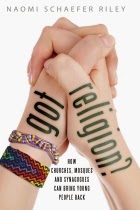Book Review: "Got Religion?" by Naomi Schaefer Riley
Got
Religion? How Churches, Mosques and Synagogues Can Bring Young People Back
Naomi
Schaefer Riley
Templeton
Press
300
Conshohoken State Road, Suite 500
West
Conshohoken, PA 19428
ISBN:
978-1-59947-391-8; $19.96; May 20, 2014
Reviewed by Rev. Dr. Michael Philliber for Deus Mistereatur
Perceptive and
Personable – 4 stars out of 5
Where have the college and post college crowd gone? This
question engages my cerebral energies often, because I work with the teenagers
of our church who are about to head to college, and co-pastor a congregation
that has a noticeable number of middle aged men and women. So, where have the
college and post college crowds gone? Naomi Schaefer Riley, an accomplished
author who is also a weekly columnist for the New York Post and
a former Wall Street Journal editor, delves into this difficulty
and how to interest them, in her newest 174 page hardback, “Got Religion? How
Churches, Mosques and Synagogues Can Bring Young People Back.” This easy-to-read
volume walks through the storied approaches of diverse groups attempting to touch
the twenty and thritysomethings in their world.
In “Got Religion?” we are privileged to listen, with the
author, to the anecdotes and narratives, feats and failures, of Presbyterian,
Muslim, Jewish, Mormon and Black Baptist institutional leaders who are
succeeding in reaching the college and post college crowd in some way. But we are
also favored to hear the yearnings and longings, along with the turn-ons and
turn-offs, of the younger people who have become involved in these establishments.
The importance of community and neighborhood, the “sense of belonging” (142),
rings out clearly in many of the accounts, and sundry ways. Similarly, that
this is a generation “particularly suspicious of bureaucracy and slick
advertising” (13) that is looking for authenticity in both leadership and laity,
surfaces often. Likewise there are also indications that “service – serious,
long-term sacrifice requiring service” (144) is alluring to this age group. Based
on these traits, Riley also points up the importance of making a place for the
twenty and thirtysomethings in leadership, that they are “often inclined to
take” the responsibilities offered to them (154).
In working through “Got Religion?” various emotions and
cogitations were triggered in me. Everything from sheer frustration over the
obvious and subtle self-centeredness exhibited in some of the statements from
this younger group, to gloomy disappointment at the misunderstandings they voiced.
And yet, their stories and concerns have prompted me to reconsider what can be done
in our particular setting as suburban church where parishioners are splattered
hither, thither and yon. Riley’s work has given me reason to pause, ponder and
pray.
“Got Religion?” will challenge several of your personal
prejudices and preconceptions, and confirm others. Nevertheless I doubt it will
be possible to examine this book and remain unaffected by it. Riley’s material
would make an ideal read for congregational leadership, Christian educators, service
agencies, and denominational committees concerned with attracting this age
group. I readily recommend the book.
(Thanks to Templeton Press for the free copy of the book
made available for this review. Feel free to repost or republish this review.
But as always, please give credit where credit is due. Mike)
You can obtain the book here.




Comments